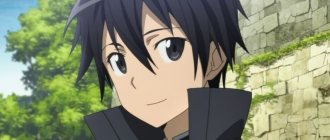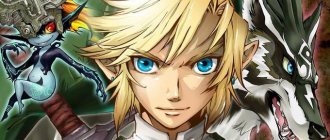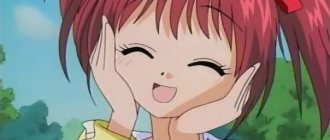What is anime
In Japan, the term "anime" (アニメ) refers to all animated works (アニメーション). The word appeared in the island state along with the development of animation technology.
The abbreviation was introduced by the inhabitants of the Middle Kingdom solely for convenience. Outside the country, only Japanese cartoons are called “anime”.
Anime is also a significant layer of culture, a whole world of images that are intertwined with manga art, cinema, public sentiment, philosophy and history.
Who is it for - children or adults?
Numerous genres and subgenres cover the interests of the entire population: children, teenagers, youth and established adults. Anime tells stories about love, the fate of a person; stories about criminal investigations, space travel and much more are popular.
The birthplace of the genre
Japan, the country from which anime originated, with its island, isolated location, has a unique mentality. Artists inspired by Disney's creations reflected their own vision of the world.
Manga - comics, which were also an adapted interpretation of the American product, had a great influence on the formation of the idea.
Anime as a culture
If all over the world cartoons are based on the plots of fairy tales, comics or films, in China anime is the primary source. Movies, videos, pop music and computer games are based on it. The exception is full-length works created based on popular manga, which have been published for years and are sold at every turn.
Taking into account the peculiarities of the mentality: great attention to detail, a penchant for symbolism, multifaceted semantic load - the creation of each character in anime is associated with long-term intellectual work.
Artists adhere to a certain color aesthetic. The color of the anime hero's eyes and clothes is a story about his personality, taking into account the meaning of shades and signs formed by the people centuries ago.
Why so popular
Anime touches on the most pressing social issues, while the characters have the same advantages and disadvantages as ordinary people. The scriptwriters pay great attention to the internal state of mind: making fateful decisions, experiences of love and loss. This appeals to the mass audience.
Watching the series is a common leisure activity for the average Japanese, and images of the characters can be found in the media, advertising, on product packaging, and street graffiti.
The spread of anime to other cultures began in the 1980s, when interest in the products of HannaBarbera, which created Tom and Jerry, Scooby-Doo and The Flintstones, began to fade. Children craved more adult media. At that time, there was no one in the world equal to Japanese anime makers.
Action-packed, dynamic animation, filled with deep meaning, reigned on the screens. Large American studios began to hire artists from Japan.
What is the difference between anime and animated films from other countries?
Most of the paintings are not intended for children at all, but for adults. This explains its widespread popularity, since anime has a much wider audience than any other cartoons or films.
The main art feature: a characteristic caricature drawing. The characters' emotions are on the verge of overacting, and every touch is important. Designers are more valued in the field than animators. The style of drawing city and natural landscapes in anime differs little from classical painting.
An anime character may suddenly turn into a kitten, or begin to discolor. Air vibrations are schematically displayed around the irritated character. This statement may seem crazy, but eccentricity is perceived by the viewer at the level of intuitive understanding.
The plot each time does not develop according to generally accepted tradition, so it is difficult to predict events. It is important to know how to watch anime correctly: complete immersion is required, otherwise it will be difficult to grasp the essence.
1980s - “The Golden Age of Anime”
The increase in interest in space sagas became even more noticeable with the release of the first film in the Star Wars . The success and popularity of this film prompted Japanese producers to finance a full-length film based on the previously released series Space Cruiser Yamato . Its appearance on screens is often associated with the beginning of a period of super-popularization, the so-called “golden age of anime” - although in fact, instead of a century, it lasted only less than fifteen years. Space Cruiser Yamato appeared on the screens, another incredibly important event for the subsequent development of Japanese animation had already taken place - the emergence of the otaku . At first, a small number of fans of rare space series of those times and science fiction united, finding each other through common hobbies and through the first anime-related magazines, such as Animage or the later Newtype . The very emergence of such magazines was a response to the growing popularity of anime in all segments of the population.
The first anime fans also appeared in other countries. Some popular anime have been imported to the US and shown on television. A common practice of that time was to rework the series before showing it: for example, “Gatchaman Ninja Scientist Team” after the first processing turned into “Battle of the Planets” , but the second turned it into “G-Force” . The iconic Space Cruiser Yamato was released in America in 1979 as Star Blazers . The most famous victim of the director's knife is the series "Robotech" , created from three different anime - "Hyperdimensional Fortress Macross" , "Hyperdimensional Cavalry of the Southern Cross" and "Mospida - a weapon of survival" . otaku grew up on these revised and expanded versions of Japanese series .
An important event was also the appearance in 1982 of a film adaptation of Rumiko Takahashi’s manga “Horrible Aliens,” directed by Mamoru Oshii. Starting out with simple doujinshi, Takahashi became famous and incredibly popular among anime fans Horrible Aliens Her subsequent works, especially Ranma 1/2 , only established her as one of the key figures in the world of manga and Japanese animation. As for Oshii, for some time now he has moved away from creating long-running popular series, and has preferred to create in a personal style, not paying attention to the opinions of fans. This allowed him to create quite original experimental works in the future.
Over time, the otaku began to have a noticeable influence on the creation of anime. Some of the first otaku became directors and animators themselves, which inevitably affected the products they produced. The most striking example of such influence is the company Daicon Films , which later became the famous Gainax . The founders of Gainax began their creative career by creating short anime films to participate in the Daicon Scifi . During these same years, one of the most famous, classic anime films, Nausicaä of the Valley of the Wind, . In the wake of its success and the ever-increasing popularity of anime, many other non-standard and ambitious films were also released, some of which still remain important today. Nausicaä director Hayao Miyazaki and his partner Isao Takahata were given the opportunity to found their own studio under the patronage of former Animage Toshio Suzuki, calling it Studio Ghibli . The first film in the future by the famous same Miyazaki.
The way anime is distributed has also evolved. In addition to the traditional broadcast of series on television, a separate sales direction has emerged, called OVA (English: Original Video Animation, “animation directly for sale on video”). As the name suggests, OVA works were not shown on television, but were immediately sold on video cassettes. The first known such creation is considered to be “Moon Base Dallas” , created under the leadership of Mamoru Oshii. Probably illustrating the phrase “the first pancake is lumpy,” “Dallas” turned out to be unpopular, but the soon-released “Megazone 23” became very, very famous, collecting a sufficient amount in sales to interest sponsors in this new product sales market. Subsequently, OVA works began to be actively used for preliminary evaluation of a work before creating its full-length or television version. Many famous series began as OVAs , but later received television or film sequels. The advent of OVAs is also associated with the emergence of the first complete pornographic anime - Hentai , before which their authors were constrained by the censorship of television and cinemas. The late 1980s became a time of big-budget and experimental productions for anime. In 1985, with the support of Toshio Suzuki, Mamoru Oshii's new film, Angel's Egg, . OVA format also allowed many short, custom titles to be published, such as Take the X Train , Neo-Tokyo, and The Robot Carnival .
Films became more and more ambitious, trying to surpass each other over and over again, and reach the heights of popularity and significance of Nausicaä . Some of the most notable films of those years included Night on the Galaxy Railroad , The Tale of Genji, and Grave of the Fireflies , all based on famous works of Japanese literature. The success of individual films led to increased funding for other projects, and the emergence of such high-budget creations as Mobile Suit Gundam: Chara Strike Back and Arion . The culmination of the costs of creating anime films were the two most expensive anime films at that time: Royal Space Corps: Wings of Honneamiz and Akira . Most of these films, however, did not pay off at the box office. Both Akira and Royal Space Corps were box office failures during their initial theatrical releases. The investment crisis that arose as a result of such dismal results caused the closure of many anime studios, while others had to abandon experiments and return to time-tested solutions and stories. One of the few to survive the downturn in Studio Ghibli's , releasing successful films with enviable consistency. Their next film, The Witch's Delivery Service , released in 1989, took first place at the box office that year, collecting more than $40 million during its theatrical run. Despite the failure of the film Akira , it was a success outside the country. Having been shown in many countries in Europe and America, the film became very popular, and even to some extent represented Japanese animation of those years in the West. With the death of Osamu Tezuka in 1989, the financial crisis and increasing international interest in anime, the period called the “golden age” is considered to be over.
The very first anime in history, who invented it
The first animation in Japan appeared at the beginning of the 20th century, pictures were drawn with chalk and filmed. Limited resources prevented the development of any technology, and the Kanto earthquake in 1923 caused enormous damage to the industry and the country as a whole. Existing developments were practically destroyed along with the studios.
In the 1930s, anime was mostly humorous. The Ministry of Education provided support to the studios, and their works were used as auxiliary material for schoolchildren to learn information. Before the Japanese invasion of China, many films were created for propaganda purposes by order of the military.
The first serious work of the post-war period, “The Legend of the White Snake,” tells Chinese history. The creators sought not to yield to their Western colleagues and at the same time smooth out tensions in relations with their close neighbor.
After 8 months of hard work, in which 13.5 thousand employees were involved, the creators were disappointed. The American adaptation was seriously changed, cut down, and the little red panda turned into a cat.
The first anime series, Otogi manga Calendar, directed by Ryuichi Yokoyama, was an interpretation of historical moments in pictures. Two seasons of 312 episodes were broadcast on central television, the episode length was only 3 minutes.
A significant breakthrough in Japan and immediately throughout the world belongs to Osamu Tezuka, the founder of the Mushi Production studio, and his creation Tetsuwan Atom (translated into English as “AstroBoy”). Atom is a kind robot boy with high intelligence and superpowers.
Gradually, he begins to feel like a person and protect earthlings from bandits, aliens and robots that have gotten out of control. From that moment on, the evolution of style and the very understanding of the genre began.
Osamu Tezuka, after seeing Momotara's Divine Sailors (the first Japanese animated film), began to dream of becoming an animator. In a country destroyed after the war, this was impossible, so he dedicated his destiny to improving manga, earning the title of god in this field. His dream came true only several decades later.
In 1965, Tezuka created the first color series, The Jungle Emperor, although the anime received little fame in America, we know the story under the name The Lion King. Later, the author laid the foundations for the erotic subgenre in “1001 Nights” and “Cleopatra.”
2000s
At this time, another period of active growth was observed. Anime has become universally popular outside of Japan, giving rise to the development of corresponding subcultures in many countries. Both the number of anime distributors and the number of companies producing it have increased. The volume of their products increased, and often without compromising its quality. The overall level of animation quality has increased, and computer technology has been actively used to create anime and manga. Despite the fact that the first companies licensing and distributing anime in the United States appeared long before this, the end of 1990 and the beginning of 2000 were marked by a strengthening of the positions of these companies and an increase in their number. In the American market, the anime licensing situation has become such that most anime products are licensed and published within a year of their release in Japan. This interest in anime affects its financing in Japan: many distributors, such as Geneon , sponsor the creation of individual anime series and films. The situation with anime licensing in Russia has also changed for the better: several large Russian companies have emerged from scratch, purchasing licenses and distributing anime.
With the development of technology, computer graphics are increasingly used in anime. Recently, 3D animation inserts have appeared even in not very large-scale projects. There is an anime entirely created using these techniques. For example, "Gantz" combines two-dimensional foreground characters with fully three-dimensional environments, taking cues from the manga of the same name created in the same way. Less noticeable at first glance, but much more important, was the complete transition to computer graphics processing. Today, the graphics of almost any anime are translated after rendering into a computer format, or drawn directly using graphics tablets. All work on combining images, creating animation, adding sound and music is carried out in digital form. Transferring video to film can only be done at the last stage; however, with the development of television, this is sometimes not required.
With the increase in the number of series produced, the number of non-standard, experimental films also increases. The director's usual freedom of creativity in anime makes it possible to bring the most unexpected ideas to life. However, the number of traditional series made according to all the canons of genres does not decrease. Often such works even degenerate into stereotyped creativity, which, in the opinion of many, does not represent anything worthwhile. However, some series that look completely stereotypical turn out to be quite unusual and gain considerable popularity. Such are, for example, “Love and Hina” and “School Trouble” . The growing popularity, on the other hand, has given rise to the phenomenon of anime aimed exclusively at the otaku . After the incredible success of Evangelion, many studios have tried their hand at creating series that can become "classics" for fans of Japanese animation. Another direction of development is fan service . Frames of erotic content are embedded in the video sequence of such anime, or even the entire series is dedicated to erotica, while maintaining a certain plot. Examples of anime with pronounced fanservice of this kind are Hot Summer and Maid Mei . Sometimes anime is based on popular Japanese erotic video games in the “Date Sim” , but such adaptations can also be quite serious works, such as “Canon” . Another version of fan service otaku culture in the series , in some cases - a demonstration of their “unusuality” and “detachment from the rest of the world.” , which originated back in 1980 with the “Film about Otaku” Gainax studio , was replenished with several worthy works, sometimes exploring otaku on a very serious level. For example, “Genshiken” is entirely dedicated to the subculture of fans of Japanese entertainment products.
Genres
In anime, the same genres are distinguished as in cinema and literature, but there are some peculiarities. Classification of directions is made taking into account the needs of the audience.
Main varieties:
- Kodomo are cartoons for children under 12 years old, there is no cruelty or violence, the art is often so similar to Western analogues that it is not always possible to guess where the work comes from.
- Shosen - films for boys 12-18 years old. The stories tell about male friendship and sporting achievements. The direction is characterized by dynamics, an abundance of humor, and positivity.
- Shoujo is an anime for girls 12-18 years old. The characters are endowed with attractiveness and sophistication, the storyline is built around romantic experiences. There are subgenres in which the heroine has magical powers.
- Seinen – emphatically erotic anime for adult men. Seinen does not belong to the 18+ category, its peculiarity: deepening into psychologism, satire. Romance is also present, but only as an additional storyline.
- Josei - the pictures tell about the life path of an adult woman, unlike Shojo, the characters look more realistic, there are erotic scenes. Particular attention is paid to the heroine’s childhood, her personality, and moments of meeting other characters.
In the description, they sometimes use “chan” - girl and “kun” - boy, this means that the tape belongs to Shojo or Shosen.
In addition to the main sections: comedy, action, drama, soap opera, there are specific ones:
- Dobutsu is an anime about furry creatures that look like people;
- Ikuji - brings together works showing care for a child;
- Jidaigeki - historical events of the Edo period.
- Otaku – hobbies, interests;
- Isekai – travel between worlds.
The fashionable genre of anime cartoons, Mecha, originated in Japan and then spread throughout the world. The events tell about huge humanoid robots that became the prototype of Transformers. There is a special category of films: Anti-War. Knowing the designations of styles and their translation into Russian will make it easy to navigate the proposed anime options.
100th Anniversary of Anime
According to unofficial data, 2007 marked exactly 100 years since the very first anime was created. A few years earlier, namely in 2005, a celluloid tape was found on which the frames were drawn. It is considered to be the oldest animated work, the creation of which dates back to 1907.
The tape consisted of 50 frames. They depicted an OYASH (ordinary Japanese schoolboy) writing on the blackboard the kanji: 活動写真 (katsudo sashin), which translated means “active photographs.” Afterwards he turns to the viewer and bows, taking off his hat, which was part of the then school uniform. It is unknown who the author of this animation was, and whether there was a continuation of this story or not.
Setting and relationships between characters
A special world or game space, beyond which the heroes do not go, can be written down until the emergence of the universe. The action may take place in modern reality or in its alternative version, but the setting is usually elaborate and symbolic.
In a broad sense, anime characters are endowed with such qualities as courage, self-sacrifice, courage, which arouses the sympathy of the audience and helps them develop. But the relationships between the characters can be completely different.
In the 18+ category, there are many areas about minors, same-sex love with varying degrees of frankness. Key moments of rape are scenes of sexual violence.
What anime are the most popular among anime fans?
The choice depends on preferences, but some works have found general recognition and have broken all records in world rankings. Where to start getting acquainted? For those interested in culture, this list is a must-see.
Princess Mononoke
The film, directed by Hayao Miyazake, was released in 1997, becoming the highest-grossing film in Japan. True, in the same year the place of honor had to be given to the Titanic. Prince Ashitaka defeated an ominous demon in the guise of a boar, but became a victim of a curse.
In search of healing, he was forced to leave home. On the way, he meets a warlike spirit princess who protects the forest from the insatiable townspeople.
Your name
The cult anime film by Makoto Shinkai was announced at Anime Expo 2021 and entered the top ten most watched of the year. A romantic story about a boy and a girl who suddenly began to change bodies while sleeping. The transmigration of souls stops for some unknown reason, and the heroes feel lonely.
The Rising of the Shield Hero
The series, based on the light novel, has its own website. A university student leads an ordinary life filled with hobbies. He then finds himself in an alternate universe and learns that he has been entrusted with the task of saving the world.
Latest anime
The attention of viewers is worthy of the unusual story about the school club “Hands Off the Film Club”, “The Great Pretender” from Netflix, “The Lord of Magic Unrecognized by the School”. In 2021, the second season of the series “Re:Zero” hit the TOP.
Which Miyazaki cartoons are worth watching for beginners?
The famous director not only brought glory to Japan, but also set a new standard for family cartoons. An introduction to anime always begins with a complete list of its films. Numerous fan theories and interpretations of symbols have been built around his work, discussed on forums.
Spirited Away, My Neighbor Totoro, Howl's Moving Castle
The master’s works cannot be called children’s fairy tales; as a rule, anime characters live in a state of threat of military conflict, usually starring a female character. “Spirited Away” is Miyazaki’s most important work, receiving every possible award.
Latest from the top 5
The farewell film “The Wind Rises” is dedicated to part of the creator’s biography: aviation, the passion of his life. In it, the author talks about the fate of aircraft designer Jiro Horikoshi. A poignant story about a boy who wanted to fly.
1970s
Over the next decade, television slowly but surely replaced cinemas as the most popular entertainment. Toei Animation gradually abandoned creating Disney-style musicals and switched to producing television series. The animators who worked at Mushi Production were scattered to newly created studios like Madhouse or Sunrise after Mushi suddenly went bankrupt. This redistribution of talent generally had a positive effect on the anime industry, as it allowed young animators to take key positions in the studios and subsequently experiment quite freely with the films they produced. An example of this is the 1974 television series Heidi by Isao Takahata. Being a fairly realistic drama aimed at children, the series was initially rejected by many television networks - the producers believed that children would be interested in something more fantastic, with elements of a fairy tale. "Heidi" , however, turned out to be incredibly popular not only in Japan, but also beyond its borders - in many European countries. The unexpected success of the series gave Miyazaki and Takahata the opportunity to create a literary anime, Theater of World Classics .
During these same years, another genre specific to anime emerged, mecha. Early works attributed to him include Muzinger Zed , Gatchaman Ninja Scientist Team , Battlestar Yamato, and Mobile Suit Gundam . The maturation of science fiction in anime led to a shift in the emphasis of the series from the adventures of superheroes to more realistic and elaborate space operas, where the concepts of good and evil were no longer so graphically straightforward. The characters' personalities were developed more deeply, which made it possible to consider the same problems from different points of view.
What TV series should a newcomer watch?
If your childhood passed without “Sailor Moon” and “Pokemon”, if you didn’t have your own preferences, choosing an anime is not easy. You should use the recommendations.
Death Note - all episodes, Fullmetal Alchemist, Cowboy Bebop
- “Death Note” was recognized by the Ministry of Culture as one of the best manga of all time; the anime based on the plot is popular in all countries.
- Fullmetal Alchemist" is also an adaptation of comic books that have been published for more than 10 years.
- “Cowboy Bepop” will appeal to fans of the post-apocalypse.
Best selection
TV series recommended for beginners: “Spice and Wolf”, “Snatch”, Stein’s Gate. The anime “Welcome to the Japanese Hikikomori Association” is worth paying attention to. If you don’t know what to start watching, pay attention to the generally recognized masterpieces: “Code Geass”, “Ergo Proxy”, “Elfen Lied” (they contain scenes of cruelty).
What films are worth watching?
When deciding which anime is best to watch, you need to remember that ratings in online cinemas do not always work. Iconic works would be a great start. The greatest master and screenwriter of Japanese animation is Isao Takahata. Other famous names: Mamoru Hosoda, Masaaki Yunasa, Makoto Shinkai.
Hayao Miyazake's fame has spread all over the world. In addition to the works of brilliant directors, the TOP recommendations for all time include: the fantasy film “Decorate the farewell morning with the flowers of promise”, “A Letter for Momo”, “Connected Worlds”.
Why anime is loved all over the world
Anime is a source of export income for Japan. Everyone can find a direction to their taste, and further delving into culture is a real intellectual hobby, which often becomes a profession. There are many courses on “drawing in anime style”, “learning Japanese using manga” and others.
The philosophy embedded in cartoons resonates greatly. Followers of cosplay strive to be like their favorite characters not only in appearance, but also develop similar spiritual qualities.
Why do they draw big eyes?
Where did these huge eyes come from? Every self-respecting anime fan should know about this. Initially, the trait was borrowed from Disney, but in the Japanese interpretation, the eyes are usually drawn more complexly: they have a memorable color and highlights, and correspond with the character.
An open gaze in anime is a symbol of openness; young and kind heroes are usually depicted this way. For the secretive and evil, the mirror of the soul looks sketchy. Characters with different colored eyes are not just an artist’s whim. Heterochromia is inherent in complex individuals with global goals and a unique personality.
The eyes are considered the most expressive part of the face, while a couple of lines are enough to depict the lips and nose. Ambiguous characters often look from under their brows or through their falling bangs.
Other Image Features
In Japanese painting, numerous small details prevail over bright accents. In anime style, the character of the hero is correlated with hair color and choice of clothing. Characters express emotions violently, their facial features are distorted. This was not practiced in the traditions of other countries, where body language is mainly used.
How much anime is there in the world?
According to estimates by various services, the number of anime ranges from 8,000 to 12,000. It’s difficult to say how many anime films have been created in the whole world. There are specific styles, amateur artists who share their results only within communities.
The very first love
Anime began to develop at an unprecedented speed in the 70s of the last century. Everything changed - from the drawing to the genre. In the features of the images, more attention began to be paid to the eyes of the characters - they were made more and more expressive. If in the 60s they tried to make images natural, similar to a living person, then a decade later animators improved the drawing of eyes. This made it possible to more easily reveal the range of feelings and experiences of the main characters.
The genre shuffle did not go unnoticed either. The works were intended not only for children, but also for adults. The first anime series dealt with the daily lives of studio workers. The animation was not particularly interesting for children, but it found its admirers among teenagers and part of the adult population. Even among older people, anime has become a second first love.
Over time, some studios began to form groups of authors who worked in a certain genre. For example, after the release of “Pure Romance” by Dean Studio, most of its creators were noticed in the development of the anime “The Best First Love in the World.” After the release of two seasons of this series, a full-length film and an ovashka, some creators began to work only with projects of the “shounen-ai” genre. Whether this is explained by long-term work on the anime “The Best First Love” or personal preferences is unknown.










